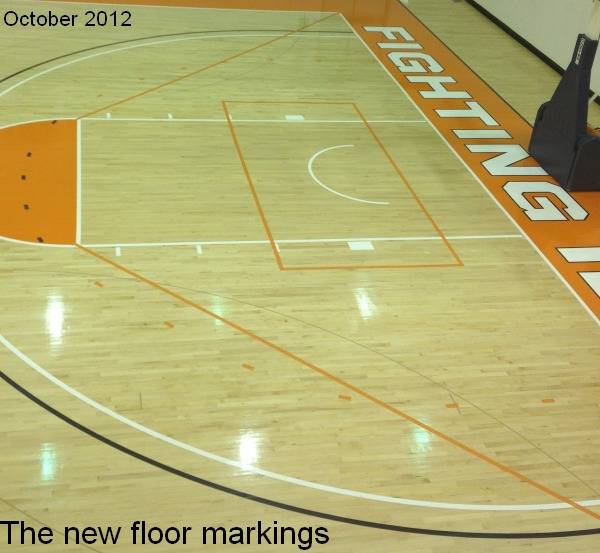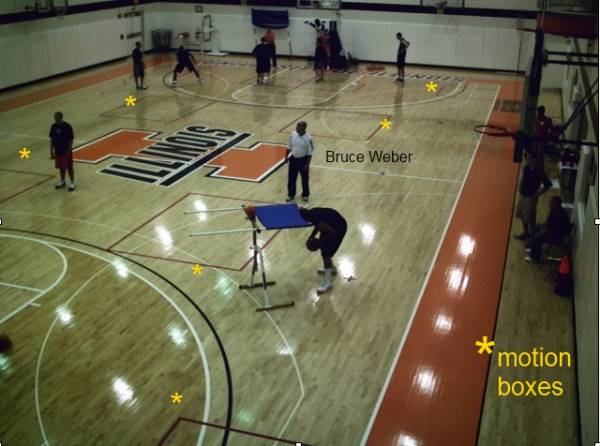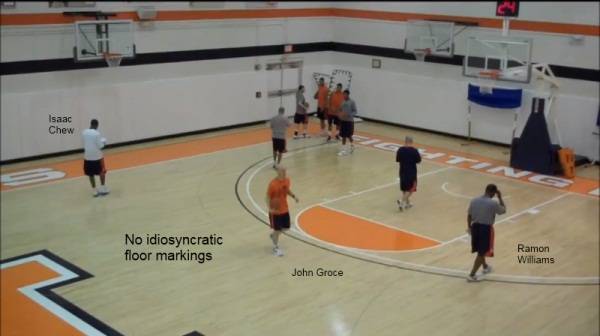The new blueprint for Illini basketball is easy to see, so long as you’re looking down.
It’s taped to the floor.

At the Ubben & Corzine Basketball Practice Facility, the free throw lanes, baselines and three-point arcs are all newish; reflecting recently departed designer Victor Cortez‘s 2011 conceptual revamp.
But even newer are the inscrutable non-regulation markings.
Gone from Corzine Gym are the familiar motion boxes of the Weber regime. John Groce replaced them with non-regulation markings of his own. The motion offense is gone too, replaced by “Flowgame,” which sounds like the anti-motion. Who can’t get excited by descriptors like “stationary” and “you just kind of wait your turn?”
The change couldn’t come too soon.
Motion boxes were a constant reminder to Weber’s players. Did they elicit a Pavlovian response in practice, in games? Maybe. In any case, it’s good to have that reminder removed.
THE MOTION PROBLEM
(Yes, I recognize that people will complain about references to the Weber years. I think it’s important to chronicle this significant change in Illini basketball strategy, by providing examples, accounts, a timeline, etc. So, to recapitulate, and flog the dead horse …)
Motion offense failed Illinois every year since Deron Williams left town. Even in 2006, the Illini offense consisted of Dee Brown dribbling a lot and then chucking a long three from the top of the key. In the meantime, Rich McBride ran the baseline, back and forth, from invisible motion box to invisible motion box.

Watch a replay of 2007’s debacle against Miami of Ohio. A freshman Mike Tisdale crisscrosses the lane repeatedly, attempting to set umpteen screens for (and against) guys who are no longer there. It’s almost funny.
In the ensuing years, Bruce Weber instituted more sets, but still relied on motion principles. These were not sets that began with five guys standing on designated spots, with movement initiated by a point guard clapping his hand to a held ball, thus triggering the first pick.
When Weber ran cold, straight set plays; they often worked. (I’ll always remember the curl route from the corner, the set play that gave D.J. the game winning shot at Indiana in 2010. That play worked for Bill Cole the next year, but I think Illinois lost that game. Illinois lost a lot of games.)
By the end, Weber had given up on motion and sets all together. Instead, he’d call out “ball screen, Joe” meaning Joe Bertrand gets the ball at the top of the key, everyone else clears out and let’s all see what happens.
Still, even then, you could see the players running toward spots on the floor. Habits are hard to break.

In the early Groce days, no markings on the floor
I asked veteran Illini players, particularly the perimeter players, about the new floor markings. What do they signify? What does it mean to you personally? What does it tell us about the new offensive and defensive schemes?
The comments were telling.
Players go through media training, kind of like debriefing in the espionage racket, before meeting the microphones. The Company Line, easily detected by its constant repetition, is that players are not thinking about the past. They are focused on the future.
But they couldn’t help themselves. It just slipped out: The old system was broken.
On the one hand, it was too confining.
Q: “Did it feel like you had to be in a particular box?”
A: “It did feel like that, but now it’s different.”
Q: “Maybe you were confined by the offense, by motion principles, being stuck in a space on the floor. Is there any truth to that?”
A:”There might be a little bit, but that’s all in the past.”
On the other hand, it was chaotic. “You’re not just moving all at once” and “you’re not just setting a pick for anybody” recalled horrors of headless chicken proportions.
This second set of quotes, you’ll notice, came without the deeply ingrained qualification. That’s because it came in response to questions about the Happy New Offense, rather than interrogatories about The Dark Old Days. Describing the new scheme, it turns out, can spark haunting memories of the old one, even without meddlesome journalists trying to provoke a reaction.
Put these concepts and responses together, and you get a sense of the problem that plagued Illini basketball these many years. Frenetic but pointless. You have to be moving, but you have to be moving here.
Flowgame might have its own discontents, but at least it will be different to look at. We’ll see the long-awaited dribble-drive. We won’t see so many half-hearted screens. We’ll see a spread floor that motion conceives, and executes, mostly in theory. We’ll still see “ball screen, Joe” because, frankly, that’s a good thing. It’s simple and effective. It will rekindle our questions about Joe Bertrand sitting at the end of the bench for two and a half years.
It might even release Brandon Paul and D.J. Richardson to do the kinds of things Illini fans thought they could do, back when Illini fans believed most of Illinois’ problems were Chester Frazier.
Now comes the new beginning. Maybe John Groce will take ownership, and accountability for Illin basketball. Maybe he can get these guys to play basketball freely, purely; for the enjoyment of the game, for the love of competition.
The players seem ready. They are now thinking outside the box.








